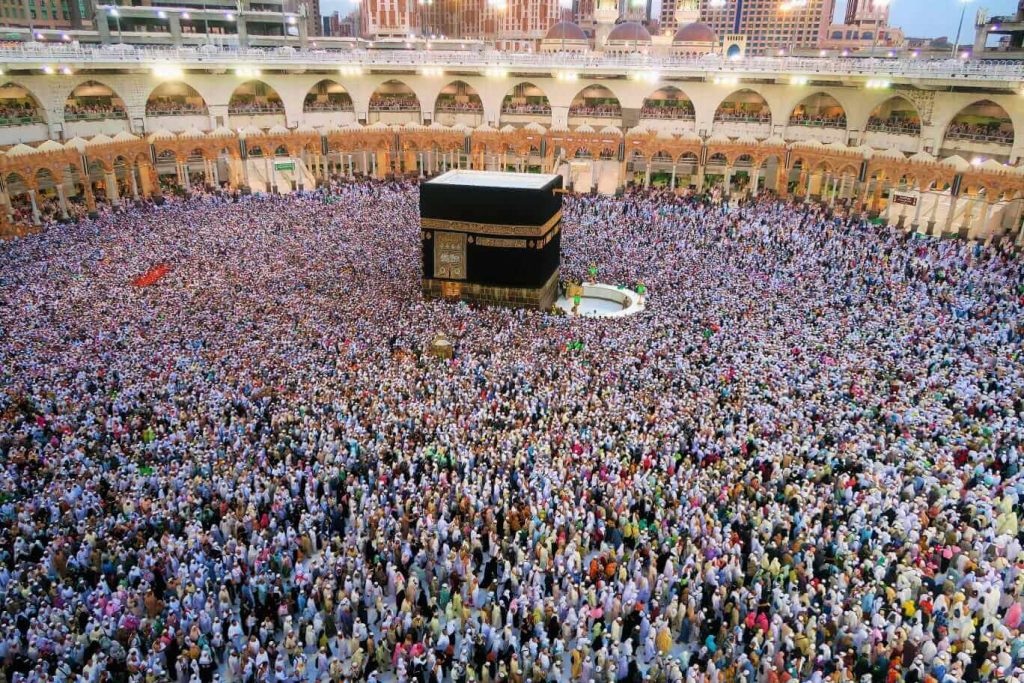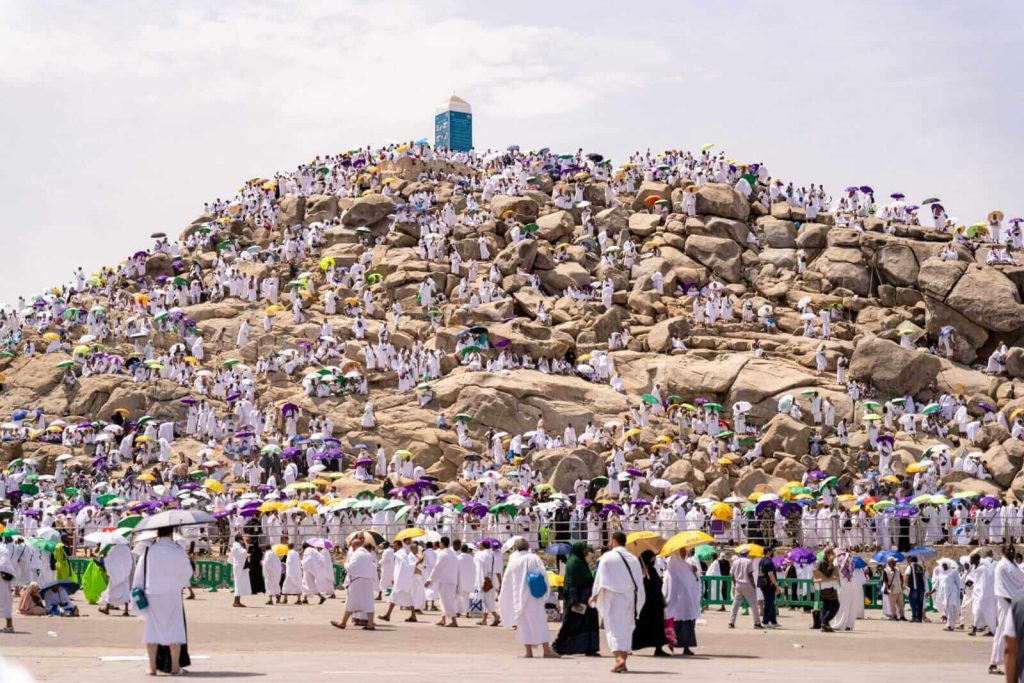
Religious Tourism in Kingdom of Saudi Arabia for Muslims
Saudi Arabia is home to some of the most significant religious sites in Islam. Here’s a detailed guide to the top Muslim religious tourism sites in the Kingdom, including their significance, rituals, and unique features:
1. Mecca (Makkah)

Religious Significance:
- Kaaba: Located in the Masjid al-Haram, the Kaaba is the most sacred site in Islam. It is the qibla (direction) towards which Muslims pray. During Hajj and Umrah, millions of pilgrims perform the Tawaf, walking around the Kaaba seven times.
- Masjid al-Haram: The Grand Mosque surrounding the Kaaba, it is the largest mosque in the world and the focal point of the Hajj pilgrimage.
Religious Rituals:
- Hajj: An annual pilgrimage that every Muslim must undertake at least once in their lifetime, provided they are physically and financially able. It involves a series of rituals including Tawaf, Sa’i (walking between Safa and Marwah), and the symbolic stoning of the devil.
- Umrah: A lesser pilgrimage that can be performed at any time of the year, including Tawaf and Sa’i.
Specialty:
- Dishes: Popular dishes include Kabsa (a spiced rice dish with meat), Shawarma, and dates.
- Natural Produce: Dates from the region are renowned for their quality. The city is also known for its honey and traditional Arabic coffee.
2. Medina (Madinah)

Religious Significance:
- Al-Masjid an-Nabawi: The mosque built by the Prophet Muhammad after his migration to Medina. It houses the Prophet’s tomb and is the second holiest site in Islam.
- Quba Mosque: The first mosque built by the Prophet Muhammad, located on the outskirts of Medina.
Religious Rituals:
- Visiting Al-Masjid an-Nabawi: Pilgrims often visit to offer prayers, especially to send salutations to the Prophet Muhammad.
- Quba Mosque Visit: It is recommended to visit the Quba Mosque and pray there, as it holds special merit.
Specialty:
- Dishes: Madinan dates are especially famous. Local cuisine features dishes like Harees (a wheat and meat porridge) and Mandi (a spiced rice dish with meat).
- Natural Produce: Medina is known for its high-quality dates and traditional Arabian coffee.
3. Mount Arafat

Religious Significance:
Mount Arafat: A key site during the Hajj pilgrimage, where pilgrims stand in earnest prayer and reflection on the Day of Arafat. It is also the site where the Prophet Muhammad delivered his Farewell Sermon.
Specialty:
- Dishes: The area is more focused on religious observance rather than local cuisine. Pilgrims usually bring their own provisions.
- Natural Produce: The area around Mount Arafat is mostly arid and does not have significant local produce.
4. Mina

Religious Significance:
Mina: Known as the tent city where pilgrims stay during Hajj. It is the site of the symbolic stoning of the Jamarat, where pilgrims throw pebbles at three pillars representing Satan.
Religious Rituals:
Stoning of the Jamarat: This ritual takes place over three days and involves throwing pebbles at three stone pillars. It symbolizes rejecting evil.
Specialty:
- Dishes: Mina is primarily a place for pilgrimage, so local cuisine is not a focal point. Most food is provided by the Hajj authorities.
- Natural Produce: The area is largely desert with minimal local produce.
5. Jeddah
Religious Significance:
Historic Sites: Jeddah is the main gateway for pilgrims entering Mecca and Medina. It has historical Islamic sites like the Historic Jeddah area and old mosques.
Religious Rituals:
Preparation for Hajj and Umrah: Pilgrims often stay in Jeddah before heading to Mecca. Many perform Umrah or prepare for the Hajj from here.
Specialty:
- Dishes: Jeddah is known for its seafood and traditional Saudi dishes. Try dishes like Sayadiyah (fish with rice) and Jareesh (crushed wheat with meat).
- Natural Produce: Jeddah’s coastal location means fresh seafood is a staple. The city is also known for its vibrant markets and traditional crafts.
6. Taif
Religious Significance:
Historical Significance: Taif is historically significant as it is mentioned in Islamic history in relation to the events of the Prophet Muhammad’s life.
Religious Rituals:
Visiting Historical Sites: Pilgrims visiting Taif often explore historical Islamic sites and enjoy the cooler climate and mountainous scenery.
Specialty:
- Dishes: Taif is known for its apples and rose products. Local cuisine includes dishes like Mandi and various traditional stews.
- Natural Produce: Taif is famous for its apples and rosewater. The cooler climate makes it suitable for fruit cultivation.
Conclusion
Each of these sites offers unique spiritual experiences and cultural insights, deeply intertwined with the practices and history of Islam. Pilgrims and visitors not only engage in religious rituals but also have the opportunity to explore the local culture, cuisine, and natural beauty of these regions.
Here’s a detailed day-wise travel itinerary for visiting key religious and cultural sites in Saudi Arabia. This plan assumes a starting point of Jeddah, which is a common entry point for pilgrims traveling to Mecca and Medina. The itinerary includes travel distances, modes of travel, and estimated travel times, as well as accommodation options for different budgets.
Day 1: Arrival in Jeddah
Arrival:
Airport: King Abdulaziz International Airport, Jeddah (JED).
Accommodation Options:
- Elite:
- Hotel: The Ritz-Carlton, Jeddah
- Location: Central Jeddah
- Amenities: Luxury rooms, pool, spa, fine dining.
- Medium:
- Hotel: Holiday Inn Jeddah Gateway
- Location: Near Jeddah Mall
- Amenities: Comfortable rooms, fitness center, dining options.
- Economy:
- Hotel: Ibis Jeddah City Center
- Location: Central Jeddah
- Amenities: Basic but clean rooms, affordable rates.
Activities:
Visit: Jeddah Corniche and Al-Balad (Historic Jeddah).
Day 2: Jeddah to Mecca
Travel:
- Distance: Approximately 80 km
- Mode of Travel: Taxi or private car
- Travel Time: 1 to 1.5 hours
Accommodation Options in Mecca:
- Elite:
- Hotel: Abraj Al Bait Clock Royal Tower
- Location: Adjacent to Masjid al-Haram
- Amenities: Luxury rooms with views of the Kaaba, multiple dining options.
- Medium:
- Hotel: Hilton Suites Makkah
- Location: Near Masjid al-Haram
- Amenities: Comfortable suites, dining facilities.
- Economy:
- Hotel: Ibis Styles Makkah
- Location: Near Masjid al-Haram
- Amenities: Affordable rooms, basic amenities.
Activities:
- Perform: Umrah (if not during Hajj season)
- Visit: Masjid al-Haram, Kaaba.
Day 3: Mecca to Mina
Travel:
- Distance: Approximately 8 km
- Mode of Travel: Taxi or shuttle bus (provided during Hajj season)
- Travel Time: 20 minutes
Accommodation:
Hajj Tent City: Pilgrims usually stay in tents provided by the Hajj authorities.
Activities:
Participate: Stoning of the Jamarat (during Hajj).
Special Note: Mina is mostly a temporary camp during Hajj, so there are no permanent hotels.
Day 4: Mina to Mount Arafat
Travel:
- Distance: Approximately 20 km
- Mode of Travel: Shuttle bus (during Hajj season)
- Travel Time: 30 minutes
Activities:
Participate: Standing (Wuquf) on the Day of Arafat (during Hajj).
Accommodation:
Hajj Tent City: Return to Mina or stay in Arafat tents if provided.
Day 5: Mecca to Medina
Travel:
- Distance: Approximately 340 km
- Mode of Travel: Train or private car
- Travel Time: 2.5 to 3.5 hours by train; 4 to 5 hours by car
Accommodation Options in Medina:
- Elite:
- Hotel: The Oberoi Madina
- Location: Near Al-Masjid an-Nabawi
- Amenities: Luxurious rooms, fine dining, spa.
- Medium:
- Hotel: Millennium Taiba Hotel
- Location: Near Al-Masjid an-Nabawi
- Amenities: Comfortable rooms, dining facilities.
- Economy:
- Hotel: Ibis Styles Madinah
- Location: Near Al-Masjid an-Nabawi
- Amenities: Budget-friendly, basic facilities.
Activities:
- Visit: Al-Masjid an-Nabawi, Quba Mosque.
- Explore: Historical sites and local markets.
Day 6: Medina to Taif
Travel:
- Distance: Approximately 240 km
- Mode of Travel: Private car or taxi
- Travel Time: 3 to 4 hours
Accommodation Options in Taif:
- Elite:
- Hotel: InterContinental Taif
- Location: Central Taif
- Amenities: Luxury rooms, gardens, dining options.
- Medium:
- Hotel: Boudl Taif
- Location: Near central Taif
- Amenities: Comfortable rooms, dining facilities.
- Economy:
- Hotel: OYO 152 Al Murjan
- Location: Central Taif
- Amenities: Budget-friendly, basic facilities.
Activities:
Explore: Taif’s historical sites, local markets, and natural attractions.
Travel:
- Distance: Approximately 170 km
- Mode of Travel: Private car or taxi
- Travel Time: 2 to 3 hours
Accommodation in Jeddah (if staying an extra night):
- Elite: The Ritz-Carlton, Jeddah
- Medium: Holiday Inn Jeddah Gateway
- Economy: Ibis Jeddah City Center
Activities:
Visit: Additional sightseeing or shopping in Jeddah.
Notes:
- Travel Modes: Renting a car is often the most convenient for intercity travel. Trains are available between Jeddah and Medina, with advanced booking recommended.
- Accommodation: Book hotels well in advance, especially during the Hajj season or peak times. Prices and availability can vary significantly.
This itinerary provides a comprehensive guide for visiting major religious sites and enjoying the local culture and cuisine in Saudi Arabia. Adjustments can be made based on specific travel dates and personal preferences.
Best Season to Visit Saudi Arabia
1. Best Season:
Winter (November to March): This is the most comfortable time to visit Saudi Arabia due to the cooler temperatures and pleasant weather. Daytime temperatures range from 15°C to 30°C (59°F to 86°F), making it ideal for sightseeing and outdoor activities. It’s also the peak season for religious pilgrimages (Hajj and Umrah) and other cultural events.
2. Summer (June to August):
Climate: Extremely hot, with temperatures often exceeding 40°C (104°F). Coastal areas like Jeddah and the Eastern Province can be humid, making it less comfortable for sightseeing.
3. Ramadan (Dates Vary):
Special Considerations: During Ramadan, fasting from dawn to sunset affects daily routines, including dining and business hours. Visiting during this time provides a unique cultural experience but requires planning around fasting hours.
Packing Details
1. Clothing:
- For Men: Lightweight, long-sleeved shirts and long trousers. A light jacket may be necessary for cooler evenings. Traditional attire (thobe) is also common.
- For Women: Loose-fitting, long-sleeved dresses or abayas (traditional black cloaks). A headscarf (hijab) is required in public spaces.
- Comfortable Footwear: Essential for walking, especially if visiting religious sites or engaging in outdoor activities.
- Sun Protection: Sunglasses, a wide-brimmed hat, and sunscreen are crucial due to the strong sun.
2. Other Essentials:
- Travel Adapter: Saudi Arabia uses the Type G electrical plug. Check your device compatibility and bring a suitable adapter.
- Medication: Carry any necessary prescription medications, as pharmacies may not stock certain brands.
- Reusable Water Bottle: Staying hydrated is important, especially in hot weather.
Traveling to Saudi Arabia from Various Parts of the World
1. Direct Flights:
- From North America: Major airlines like Saudi Arabian Airlines, Delta, and American Airlines offer direct flights to cities like Jeddah and Riyadh.
- From Europe: Direct flights are available from major cities such as London, Paris, and Frankfurt with airlines like British Airways, Air France, and Lufthansa.
- From Asia: Direct flights are available from cities like Dubai (Emirates), Bangkok (Thai Airways), and Mumbai (Air India).
2. Connecting Flights:
From Other Regions: Passengers from regions without direct flights can connect through major hubs in the Middle East (e.g., Dubai, Doha) or Europe.
Visa Requirements
1. Tourist Visa:
- Eligibility: Citizens of eligible countries can apply for an eVisa online. This visa is typically valid for tourism or business and allows multiple entries.
- Application: Apply through the Saudi eVisa portal. Required documents include a passport with at least six months validity, a recent photo, and travel insurance. Some countries also require proof of accommodation and onward travel.
- Processing Time: Usually a few days to a week.
2. Hajj/Umrah Visa:
- Hajj Visa: Required for the annual pilgrimage, usually arranged through travel agencies specializing in Hajj packages. Strict deadlines and quotas apply.
- Umrah Visa: Available for pilgrims visiting outside of the Hajj season. Apply through an approved travel agency. Proof of travel arrangements and accommodation is required.
3. Business Visa:
- Eligibility: For business travelers. Requires an invitation letter from a Saudi company, along with standard visa application documents.
- Application: Apply through the Saudi consulate or embassy in your country.
4. Other Visa Types:
- Work Visa: For those moving to Saudi Arabia for employment. Requires a work contract and additional paperwork.
- Residency Visa: For long-term stays or family reunification, requiring sponsorship and approval from Saudi authorities.
Conclusion
The best time to visit Saudi Arabia is during the cooler winter months, with comfortable packing including modest clothing, sun protection, and necessary travel essentials. Traveling to Saudi Arabia can be done via direct or connecting flights from various global locations. Ensure to check visa requirements based on your purpose of visit and nationality, applying in advance to ensure a smooth entry.
Travel Details and Visa Requirements for Religious Tourists from Pakistan and India
Travel Details
1. Direct Flights:
- From Pakistan:
- Airlines: Pakistan International Airlines (PIA), Saudi Arabian Airlines, and other international carriers.
- Major Routes: Direct flights from major cities such as Islamabad, Karachi, and Lahore to Jeddah (JED) and Riyadh (RUH).
- From India:
- Airlines: Air India, Saudi Arabian Airlines, Emirates, and other international carriers.
- Major Routes: Direct flights from cities such as Delhi, Mumbai, Bengaluru, and Hyderabad to Jeddah (JED) and Riyadh (RUH).
2. Connecting Flights:
For both countries: If direct flights are not available from your city, you can connect through major Middle Eastern hubs like Dubai (DXB), Doha (DOH), or Abu Dhabi (AUH).
Visa Requirements
1. Tourist Visa:
- Eligibility: Citizens of Pakistan and India are eligible for tourist visas, but requirements can vary based on nationality and the purpose of the visit.
- Application:
- For Pakistanis: Apply through the Saudi eVisa portal or at the Saudi Arabian embassy or consulate.
- For Indians: Apply through the Saudi eVisa portal or at the Saudi Arabian embassy or consulate.
- Required Documents:
- Passport: Valid for at least six months from the date of entry.
- Photo: Recent passport-sized photo.
- Travel Insurance: Proof of insurance covering the duration of your stay.
- Accommodation Proof: Confirmation of hotel bookings or accommodation.
- Return Ticket: Proof of onward or return travel.
- Processing Time: Generally a few days to a week.
2. Hajj Visa:
- Eligibility: For performing Hajj, typically arranged through approved travel agencies specializing in Hajj packages.
- Application:
- For Pakistanis: Apply through registered Hajj tour operators. The visa is issued based on a quota system.
- For Indians: Apply through registered Hajj tour operators or through the Indian Hajj Committee.
- Required Documents:
- Passport: Valid for at least six months.
- Hajj Package: Confirmation of booking with an approved tour operator.
- Medical Certificate: Proof of vaccinations and health checks.
- Photographs: Recent passport-sized photos.
- Processing Time: Typically depends on the Hajj season and the tour operator’s processing time.
3. Umrah Visa:
- Eligibility: For performing Umrah at any time of the year.
- Application:
- For Pakistanis: Apply through an approved travel agency specializing in Umrah packages.
- For Indians: Apply through an approved travel agency or through the Indian Ministry of Hajj.
- Required Documents:
- Passport: Valid for at least six months.
- Umrah Package: Confirmation of booking with an approved agency.
- Travel Insurance: Proof of insurance.
- Accommodation Proof: Details of stay in Saudi Arabia.
- Return Ticket: Proof of onward or return travel.
- Processing Time: Generally a few days to a week, depending on the travel agency and season.
4. Business Visa:
- Eligibility: For those traveling for business purposes.
- Application:
- For Pakistanis: Apply through the Saudi embassy or consulate, with an invitation letter from a Saudi company.
- For Indians: Apply through the Saudi embassy or consulate, with an invitation letter from a Saudi company.
- Required Documents:
- Passport: Valid for at least six months.
- Invitation Letter: From the Saudi company or organization.
- Photo: Recent passport-sized photo.
- Business Documentation: Proof of business or employment.
- Processing Time: Usually a few days to a week.
5. Work/Residency Visa:
- Eligibility: For long-term stays or employment.
- Application:
- For Pakistanis: Requires a work contract or sponsorship. Apply through the Saudi embassy or consulate.
- For Indians: Requires a work contract or sponsorship. Apply through the Saudi embassy or consulate.
- Required Documents:
- Passport: Valid for at least six months.
- Work Contract: Copy of employment or sponsorship agreement.
- Medical Certificate: Health check and vaccination records.
- Photo: Recent passport-sized photo.
- Processing Time: Varies depending on the type of visa and documentation.
Additional Tips:
- Visa Fees: Visa fees can vary, so check the latest rates on the Saudi embassy or consulate website.
- Travel Insurance: Highly recommended for all travelers to cover unexpected medical and travel issues.
- Health Precautions: Ensure vaccinations and health checks are up-to-date, especially for Hajj and Umrah.
Always check the latest visa policies and travel advisories from official sources or the Saudi Arabian embassy/consulate in your country before planning your trip.




